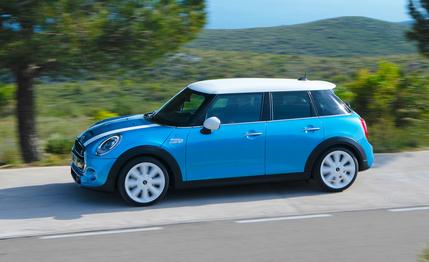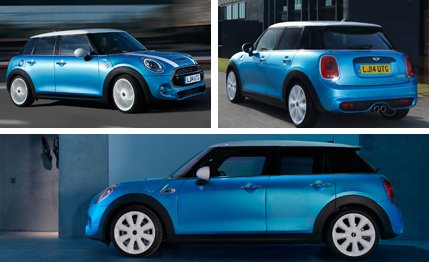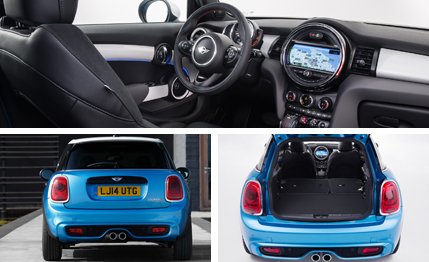
 First Drive Review
First Drive Review
Although most Mini models to date have had rear accommodations, those seats suggested more practicality than they actually delivered. The latest Mini Cooper hardtop, for example, is about as well-suited to carrying adult passengers in the back as a Little Tikes Cozy Coupe—and that thing doesn’t even have back seats. For 2015, however, Mini is finally delivering a practical five-door hatchback with more rear legroom and improved ingress and egress.
The Hardtop 4-Door, as Mini has dubbed it, packs 2.9 additional inches of wheelbase and is 6.3 inches longer overall. More than half of the extra wheelbase (1.5 inches) goes into rear seat legroom, and it transforms those perches into somewhat usable stowage for grown-ups. Steerage class still isn’t spacious, but thanks to deeply hollowed out front seatbacks, a near-six-footer can sit behind a similarly sized driver without embedding his knees permanently in the seat structure. A slightly taller roof that’s more horizontal than the three-door’s provides adequate headroom.
The balance of the stretch goes into a larger luggage area, which grows from 8.7 to 13.1 cubic feet with the rear seat in place and from 38.0 to 40.7 with it folded. A new 60/40 folding seatback allows this additional volume to be allocated between passengers and stuff as needed. The Hardtop 4-Door still can’t match the packaging magic of the Honda Fit, and is more like the Ford Fiesta in both exterior size and interior space.


Of course, the Mini costs considerably more than either the Fiesta or the Fit. The two additional doors nick you for an additional $1000 over the basic Mini, with the base 2015 Cooper five-door costing $22,300 and the Cooper S version that we drove for this report starting at $25,950. That’s roughly three grand more than a Ford Fiesta ST, a 10Best-winning, four-wheeled riot. And, of course, Mini offers far, far more options than Ford does, and so a 4-Door approaching $40,000 is within the realm of possibility.
Automatically Moved
Our first drive in the 4-Door was limited to the Cooper S with the automatic transmission. Such a pairing is generally agreeable (if not terribly involving), as the modestly boosted 2.0-liter inline-four develops plenty of torque very quickly at even low rpm. It feels like a larger, naturally aspirated engine. Combined with a well-calibrated throttle and well-coordinated shift points, the powertrain produces smooth and linear thrust.
Like its three-door sibling, this new model feels very solid and more substantial than its size. Steering effort is not light or heavily damped, yet it is more reactive than that of most other cars. Even so, the Cooper S, while agile, never feels twitchy. The larger body with the extra doors adds about 135 pounds to curb weight, an increment that isn’t immediately obvious in the driving experience.
On English roads, the suspension calibration delivered a great combination of control and suppleness in its middle setting. But when switched to Sport, the shocks turned much firmer and made the car pogo over most bumps. This was perhaps to be expected—a ring of LEDs around the central display glow red momentarily when you switch to Sport, while the center screen promises “maximum go-kart feel” and displays an outline of the car with a thought bubble near the driver's head that’s filled with a picture of a rocket.
Such visual excitement is everywhere in this generation Mini Cooper; that same circular ring of LEDs also functions as a temperature-change indicator when you fiddle with the HVAC settings as well as a secondary tachometer during normal driving. There’s also a large glowing arc of subtle lighting in all four door panels, as well as a gas gauge that consist of a series of discreet, horizontal LEDs.


Such visual creativity is what your money buys in a Mini. The interior of our Cooper S was well-executed and finished with highly sculpted, three-dimensional dash panels, elegant matte-finish wood trim, and lots of attractive brightwork. The switches and controls all feel high quality and move with precision.
British via Bavaria
This should come as no surprise because this Mini is essentially a BMW under its skin. Although there are some different graphics, the infotainment system is pure iDrive and controlled by a large central knob. The small screen in the speedometer dial is also straight from the Bimmer parts pile, and is controlled by a button at the end of the turn signal stalk just like it is on any BMW. Even most of the engineers and marketing experts on hand spoke with strong German accents.
Going farther, the mechanical bones of this car have deep BMW roots. The four-cylinder engine in the Cooper S as well as the three-cylinder variant in the base Cooper, are members of the new engine family that will soon be under the hood of most BMWs. Similarly, this front-drive architecture also will form the basis of the next generation 1-series cars—marking the first time that a BMW sedan exclusively will drive the wheels up front.
All of this to say that, in addition to its iconic and high style, this Mini delivers BMW technology in its tiny package. For customers who don’t want to sacrifice sophistication when they downsize—and are willing to pay a substantial premium for it—the new Hardtop 4-Door fits the bill. Then again, so does the one-class-up $21,515 five-door Volkswagen Golf, although that car lacks the design panache of the Mini. It does, however, also have a usable rear seat.